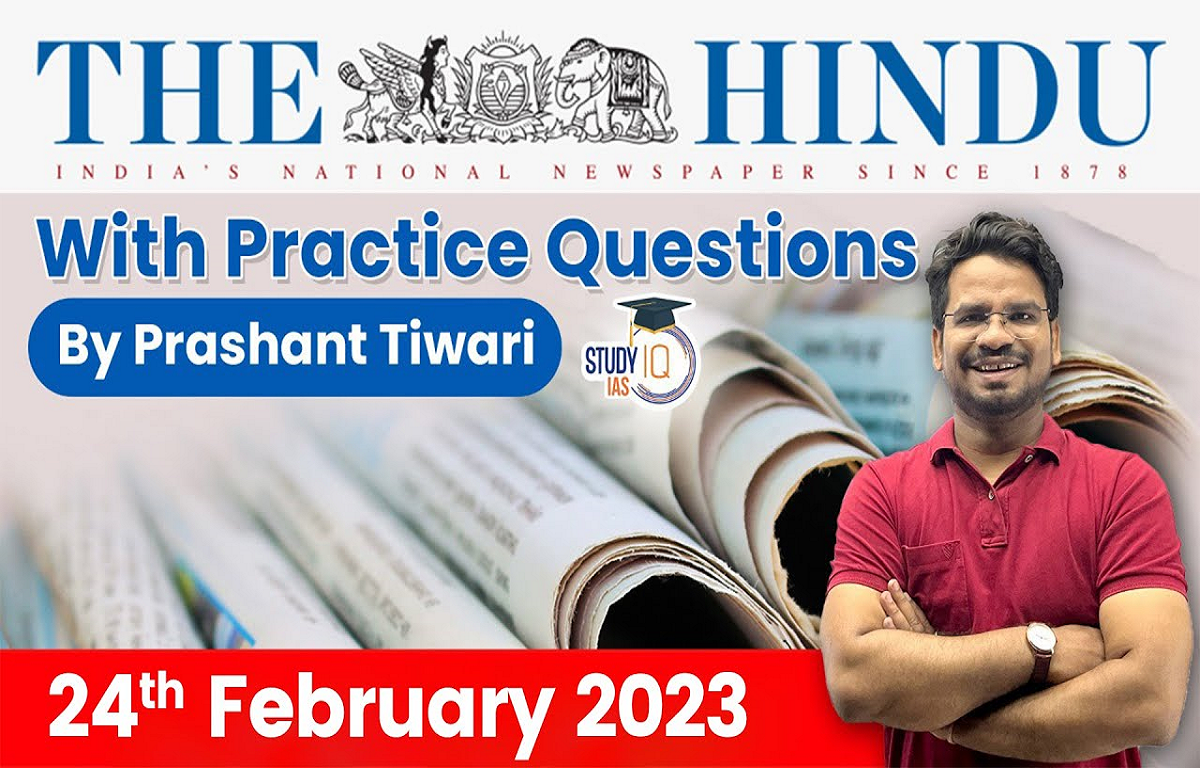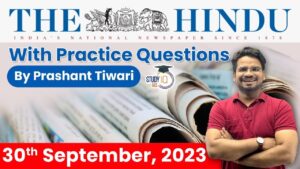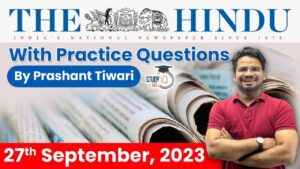The Hindu Newspaper Analysis for UPSC

The Hindu Newspaper Analysis 21 February 2023
- Up to five lakh patients have benefited since October last year from QR code-enabled registration at hospital counters, which has helped reduce long queues, the Ministry of Health and Family Welfare said on Thursday.
- The Ministry’s National Health Authority (NHA) under the Ayushman Bharat Digital Mission (ABDM) introduced the “scan and share” service for faster Outpatient Department (OPD) registrations in October 2022.
- “The ‘scan and share’ service is a typical example of how technology can be leveraged to provide better services to patients and to improve the system efficiency,” Dr. Garg said.

- The anti-defection law was introduced into the Constitution via the Tenth Schedule, in 1985.
- The Tenth Schedule sought to put a stop to this by stipulating that if any legislator voted against the party whip, he or she would be disqualified from the house.
- While on the one hand this empowered party leadership against the legislative backbench, and weakened the prospect of intra-party dissent.
- This is where the role of the Supreme Court becomes crucial. Disputes over government formation and government toppling invariably end up before the highest court.
- If, for example, it is held that a Speaker cannot decide a disqualification petition while under a notice for removal themselves, and that a floor test can be ordered in the interim (by the Governor or the court), the consequences are obvious: a “rebel MLA” can move a notice for removal, incapacitate the Speaker from taking action, and leave rebel MLAs free to bring down the government without consequence.

- In 1959, the United Nations General Assembly adopted the Declaration of the Rights of the Child, the first charter of its kind ensuring basic rights to all children below 18 years, with these words: “Mankind owes to the child the best it can give.”
- Yet, as is well-documented, children, because of their vulnerability, often become victims of abuse of power by the very people who are entrusted with their protection.
- Leaning on a child’s fundamental right to privacy, the Supreme Court of India has ruled that children cannot be mechanically subjected to DNA tests in each and every case between warring parents as a shortcut to establishing infidelity.
- Directing courts to acknowledge that children must not be regarded as material objects, and that they be subjected to forensic/DNA testing only as a last resort particularly when they are not parties to a divorce proceeding, Justice Nagarathna observed that it is imperative that children do not become the focal point of the battle between spouses.
- While this is a welcome move, a reading of the 1989 United Nations’ Convention on the Rights of the Child shows that there are miles to go before every child in India is guaranteed “special care and assistance”.
- India ratified the Convention in 1992 and over the years several laws have been enacted to protect the rights of children though their implementation has often been dodgy, failing to shield them from abuse, violence, exploitation or neglect.
National Commission for Protection of Child Rights:
- The National Commission for Protection of Child Rights (NCPCR) is a statutory body established under the Commission for Protection of Child Rights (CPCR) Act, 2005.
- It is under the administrative control of the Ministry of Women and Child Development.
- Under the act, a Child is defined as a person in the 0 to 18 years age group.
- It aims to ensure that all Laws, Policies, Programmes, and Administrative Mechanisms are in harmony with the Child Rights perspective as enshrined in the Constitution of India and also the UN Convention on the Rights of the Child.

- Recently, India’s Unified Payments Interface (UPI) and Singapore’s PayNow have been integrated to enable faster Remittances between the two countries.
- Singapore has become the first country with which cross-border Person to Person (P2P) payment facilities have been launched.
- The project is expected to greatly benefit the Indian diaspora, especially migrant workers and students, in Singapore as it allows faster and cost-efficient funds transfer across both countries without the mandate of getting onboard the other payment system.
- As per the ministry of external affairs (MEA) document Population of Overseas Indians (2022), there are approximately 6.5 lakh Indians, including non-resident Indians and persons of Indian origin, currently residing in Singapore.
- Of the total inward remittances to India in 2020-21, the share of Singapore stood at 5.7%, according to the RBI (Reserve Bank of India) Remittance Survey, 2021.
UPI and Paynow
- UPI is India’s mobile-based fast payment system, which facilitates customers to make round-the-clock payments instantly, using a Virtual Payment Address (VPA) created by the customer.
- UPI supports both Person-to-Person (P2P) and Person-to-Merchant (P2M) payments and it also enables a user to send or receive money.
- PayNow is a fast payment system in Singapore. It enables peer-to-peer funds transfer service, available to retail customers through participating banks and Non-Bank Financial Institutions (NFIs).

- India’s research and development (R&D) expenditure-GDP ratio of 0.7% is very low when compared to major economies and is much below the world average of 1.8%.
- The main reason is the low investment in R&D by the corporate sector. While the corporate sector accounts for about two-thirds of gross domestic expenditure on R&D (GERD) in leading economies, its share in India is just 37%.
- The National Science and Technology Management Information System (NSTMIS) of the DST is the agency that compiles GERD statistics in India.
- It is easier to gather the information on R&D by the government sector, the higher education sector and public sector enterprises. The challenge lies in collecting data from the private corporate sector.

- Over 60% of India’s 94.5 crore voters in India have linked their Aadhaar number to their voter IDs, the Election Commission (EC) disclosed in a Right to Information response obtained by The Hindu. The total number of voters who have their Aadhaar linked is 56,90,83,090.
- Tripura, which went to the polls last week, had the highest rate of Aadhaar linking; over 92% of voters in the State have provided their Aadhaar details to the Election Commission.
- Some of these voters may have provided documents other than Aadhaar, such as PAN, Driving License, or Passport, to fill out Form 6B, which the EC introduced last year. However, the form primarily demands Aadhaar, and electors can only provide an alternative document after declaring that they do not have an Aadhaar.
- The Election Laws (Amendment) Act, 2021 was passed to deduplicate electoral rolls by allowing election authorities to collect the 12 digit number from voters.
- The per-State percentages given here are based on total voter enumerations released by States and Union Territories in the past three years. After Tripura, Lakshadweep and Madhya Pradesh occupy the second and third spots, with over 91% and 86% of voters having provided the number respectively.
- Voters in southern States have not provided their Aadhaar in such proportions, even though they are above the national average. Andhra Pradesh and Karnataka both fell shy of 71%, whereas the number stands around 63% and 61% for Tamil Nadu and Kerala.
- The State with the lowest Aadhaar registration by voters is Gujarat, where only 31.5% of voters have linked the document to their voter registration. Less than 34% of voters in the national capital had their Aadhaar linked.

- Observing that culture was the real identity of a country, President Droupadi Murmu on Thursday said India’s unique performing arts had kept its incredible culture alive for centuries.
- “Our arts and artists are the carriers of our rich cultural heritage. Unity in diversity is the biggest feature of our cultural traditions,” the President said, while giving away the Sangeet Natak Akademi awards and fellowships for 2019, 2020 and 2021 here.
- Murmu said civilisation showcased the material achievements of a nation, but intangible heritage was revealed through its culture. “In our tradition, art is a spiritual practice, a medium of the search for truth, a medium of prayer and worship, a medium of public welfare… Art binds the linguistic diversity and regional characteristics in one thread,” she said.
Sangeet Natak Akademi
- The Sangeet Natak Akademi is India’s national academy for music, dance and drama.
- It was created by a resolution of the (then) Ministry of Education, Government of India, in 1952 with Dr P.V. Rajamannar as its first Chairman.
- It is presently an Autonomous Body of the Ministry of Culture, Government of India and is fully funded by the Government for implementation of its schemes and programmes.


 The Hindu Newspaper Analysis 6 October 2...
The Hindu Newspaper Analysis 6 October 2...
 The Hindu Newspaper Analysis 30 Septembe...
The Hindu Newspaper Analysis 30 Septembe...
 The Hindu Newspaper Analysis 27 Septembe...
The Hindu Newspaper Analysis 27 Septembe...





















